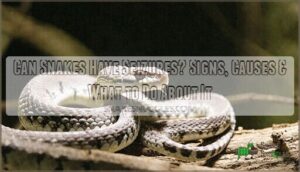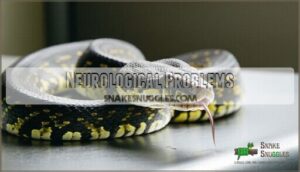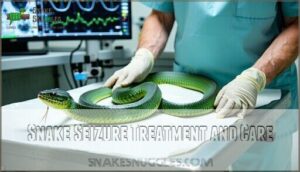This site is supported by our readers. We may earn a commission, at no cost to you, if you purchase through links.
 Yes, snakes can have seizures, and you’ll know something’s wrong when your snake starts showing bizarre behaviors like head wobbling, corkscrewing movements, or that unsettling "stargazing" pose where they crane their necks upward.
Yes, snakes can have seizures, and you’ll know something’s wrong when your snake starts showing bizarre behaviors like head wobbling, corkscrewing movements, or that unsettling "stargazing" pose where they crane their necks upward.
These seizures aren’t just odd quirks—they’re serious medical emergencies that can stem from neurological disorders, Inclusion Body Disease, dietary deficiencies, or overheating. Unlike mammals that convulse, snakes display these distinctive twisted movements and uncontrollable head motions.
Some causes are manageable through proper temperature control and nutrition, while others require immediate veterinary care. Recognizing these warning signs early can mean the difference between a treatable condition and losing your scaled companion—and there are specific steps every snake owner should know.
Table Of Contents
- Key Takeaways
- Snake Seizures: Causes and Symptoms
- Types of Snake Seizures
- Seeking Veterinary Guidance for Snake Seizures
- Snake Seizure Treatment and Care
- Extraordinary Case: Snakes Detecting Seizures
- Frequently Asked Questions (FAQs)
- Why do snakes have seizures?
- Do garter snakes have seizures?
- Do snakes have neurological problems?
- Can snakes detect seizures?
- What animals can get seizures?
- Are seizures in pet snakes contagious?
- How long do snake seizures typically last?
- Can baby snakes be born with seizures?
- Do seizures cause pain in snakes?
- Can seizures in snakes be prevented?
- Conclusion
Key Takeaways
- You’ll recognize snake seizures through distinctive movements – head wobbling, corkscrewing body positions, and "stargazing" where your snake cranes its neck upward uncontrollably
- Multiple serious causes require immediate vet attention – genetic conditions like spider gene mutations, Inclusion Body Disease, overheating damage, and dietary deficiencies can all trigger seizures
- Proper husbandry prevents many seizure episodes – maintain correct temperatures with thermostats, provide balanced whole-prey diets avoiding thiaminase-rich fish, and minimize environmental stress
- Early intervention makes the difference between recovery and tragedy – seek emergency veterinary care immediately when you spot seizure symptoms, as quick treatment of underlying causes offers your snake the best chance of survival
Snake Seizures: Causes and Symptoms
Yes, snakes can have seizures caused by various neurological, genetic, and environmental factors.
Understanding these seizure types and their underlying causes helps you recognize when your snake needs immediate veterinary attention.
Neurological Problems
When dealing with snake seizures, neurological problems often stem from multiple sources that can disrupt your pet’s nervous system.
Snake seizures signal serious disruption in your pet’s delicate nervous system.
Genetic predisposition plays a major role, particularly in spider ball pythons where inherited traits cause head wobbling and coordination issues.
Trauma impact from injuries or accidents can damage brain tissue, leading to seizure activity.
Venom toxicity affects even non-venomous species when exposed to toxins from other animals.
Mineral imbalances, especially calcium deficiencies, frequently trigger neurological episodes.
Epilepsy onset can occur spontaneously in snakes, causing recurring seizures without obvious causes.
Snake neurological issues also arise from overheating, which damages nerve pathways over time.
Environmental stress compounds these problems, making seizures more likely.
Neurological problems in snakes require immediate veterinary attention since they often indicate serious underlying conditions that won’t resolve on their own.
Inclusion Body Disease (IBD)
While Inclusion Body Disease (IBD) affects primarily boas and pythons, this viral infection represents one of the most serious causes of snake seizures and neurological issues.
The Arenavirus behind IBD creates devastating symptoms that progressively worsen over time.
Your snake may develop these key IBD symptoms:
- Stargazing and corkscrewing movements – abnormal posturing that signals brain involvement
- Loss of righting reflex – inability to turn right-side up when flipped
- Head tremors and uncontrolled wobbling – involuntary neurological responses
- Regurgitation and failure to feed – digestive system complications
- Disorientation and behavioral changes – altered responses to environment
IBD transmission occurs through direct contact with infected bodily fluids or contaminated surfaces.
Genetic predisposition may influence susceptibility, though any boa or python can contract this disease.
IBD diagnosis requires specialized testing, including PCR analysis and histopathological examination.
Unfortunately, no cure exists for IBD.
IBD prevention focuses on strict quarantine protocols and biosecurity measures.
Emerging research continues exploring treatment options, but current management remains supportive care only.
Dietary Factors and Overheating
Diet plays a major role in snake seizures.
Thiaminase risks emerge when you feed your snake fish containing this enzyme, which breaks down essential vitamin B1.
Garter snakes face particular danger from thiaminase in their fish-heavy diets.
Overfeeding effects include Pin Head Syndrome, creating unhealthy weight gain.
Vitamin deficiencies, especially thiamine deficiency, trigger serious neurological problems and seizures.
Overheating causes thermal injuries that damage your snake’s nervous system.
High temperatures lead to burns and seizures over time.
Habitat stressors like improper temperature ranges, inadequate hiding spots, and poor ventilation worsen existing conditions.
You’ll notice warning signs like vomiting, appetite loss, and abnormal shedding patterns.
These dietary factors and environmental problems create the perfect storm for snake seizures, including thermal injuries and neurological problems, which can be exacerbated by improper temperature ranges and poor ventilation.
Types of Snake Seizures
Snake seizures come in three main types that you can identify by their distinct movement patterns. Each type indicates different underlying neurological issues and requires specific attention from a veterinarian.
Head Wobbling
When your ball python starts showing signs of head wobbling, you’re witnessing a genetic predisposition that’s particularly common in spider ball pythons.
This neurological issue causes involuntary head shaking and coordination problems that can range from mild to severe.
The spider gene creates breeding ethics concerns because wobble severity often increases with stress or improper care conditions.
Head wobbling represents one of the most recognizable snake neurological problems you’ll encounter.
The reptile’s nervous system struggles to control these movements, making simple tasks like striking at food more challenging.
While some snakes adapt well to mild symptoms, severe cases can substantially impact quality of life.
Environmental factors play a vital role in managing this condition.
Proper temperature regulation, stress reduction, and consistent husbandry practices help minimize episodes.
Understanding that head wobbling is a lifelong condition helps you provide appropriate care while recognizing when seizures in snakes require immediate veterinary attention.
Corkscrewing
Corkscrewing presents like a twisted pretzel—your snake’s body spirals and curls uncontrollably during these severe neurological episodes.
Watching your snake spiral helplessly reveals the devastating reality of severe neurological damage.
IBD Link commonly triggers this abnormal behavior, though Trauma Impact from falls or injuries can spark similar reptile seizures. Overheating Effects also contribute to corkscrewing in certain species.
Movement Analysis reveals the Severity Scale ranges from mild twisting to complete loss of body control. These snake seizures indicate serious neurological issues requiring immediate attention.
Lethargy may indicate the presence of a serious health issue. Proper housing prevents many cases, while stress reduction helps manage existing conditions through consistent environmental controls.
Stargazing
Stargazing represents one of the most alarming snake seizures you’ll encounter. This neurological issue causes your snake to twist its neck upward uncontrollably, creating a distinctive "star-gazing" posture that signals serious underlying problems.
Key stargazing indicators include:
- Behavioral Manifestations – Your snake maintains an abnormal upward head position for extended periods
- Advanced IBD symptoms like loss of coordination and involuntary muscle contractions
- Genetic Predisposition factors, especially in boas and pythons with family histories
- Long-Term Prognosis concerns requiring immediate veterinary intervention
Stargazing Diagnosis typically involves blood work and imaging to identify snake abnormal behavior patterns. This condition often indicates snake nervous system damage from Inclusion Body Disease, though overheating and trauma can trigger episodes too.
Unfortunately, once stargazing appears, it usually signals progressive neurological deterioration that won’t improve with standard treatments, making early prevention through proper husbandry your best defense against these devastating snake seizures.
Seeking Veterinary Guidance for Snake Seizures
When spotting emergency signs like uncontrolled twitching or unusual posturing, immediate veterinary consultation becomes your snake’s lifeline.
A reptile specialist can perform diagnostic tests to pinpoint causes and develop treatment plans.
Professional snake veterinary care offers several advantages:
- Accurate diagnosis through specialized equipment and experience with reptile neurological conditions
- Specialist referral to exotic animal neurologists when complex cases require advanced intervention
- Long-term prognosis assessment to help you understand your snake’s future quality of life
Your veterinarian will guide you through diagnosing snake seizures using blood work, imaging, and physical examinations. They’ll also provide owner support throughout the process, explaining treating snake seizures options and helping you make informed decisions about your pet’s care.
To guarantee proper snake care, consider the importance of temperature and humidity within the enclosure.
Snake Seizure Treatment and Care
When your snake shows seizure symptoms, quick action can make a real difference in their comfort and recovery.
Managing the underlying cause while adjusting their environment often provides the best chance for improvement.
Managing Underlying Issues
Once you’ve consulted with your veterinarian, managing underlying causes becomes your next priority. Snake neurological disorders often stem from multiple factors that require targeted approaches.
Treating snake seizures effectively means addressing genetic conditions, parasitic infections, and systemic diseases like IBD through appropriate snake veterinary care. Supportive Care forms the foundation of treatment.
Your vet may prescribe Medication Options such as anticonvulsants to control seizure episodes. Regular monitoring helps track your snake’s response to treatment and adjust protocols as needed.
Environmental Enrichment plays a substantial role in recovery. Add hiding spots, climbing branches, and varied textures to reduce anxiety. Stress Reduction techniques include maintaining consistent routines and minimizing handling during treatment periods.
The Long-Term Prognosis depends heavily on the underlying cause. Genetic conditions like spider gene mutations may require lifelong management, while infectious causes might improve with proper treatment. Diagnosing snake seizures early improves outcomes markedly.
Work closely with your exotic veterinarian to develop a thorough management plan that addresses both immediate symptoms and long-term health needs.
Dietary Changes
Proper dietary management serves as your first line of defense against snake seizure causes and related neurological issues.
Correcting dietary imbalances prevents calcium deficiencies and vitamin deficiencies that trigger seizures in captive snakes.
You’ll need to address Thiaminase Risks by avoiding fish-based diets that destroy essential B vitamins.
Instead, focus on Balanced Nutrition through whole-prey diets formulated for your snake’s specific needs.
Vitamin Supplementation becomes instrumental when natural diets lack essential nutrients—work with a reptile veterinarian to determine appropriate supplements.
Maintain Prey Variety through regular rotation to prevent nutritional monotony and support nervous system health.
Adjust Feeding Frequency based on your snake’s age and species requirements.
Commercial supplements recommended by herpetological veterinarians fill nutritional gaps effectively.
These snake diet modifications reduce metabolic stress that contributes to seizure development while supporting overall neurological function.
Ensuring snakes get the essential vitamin D3 is also imperative for their health.
Temperature Regulation
Why does temperature regulation matter so much for preventing snake seizures? Maintaining ideal thermal gradients within your snake’s enclosure is vital for preventing heat-related neurological damage that can trigger seizure episodes.
Heat-related seizures occur when snakes experience rapid or extreme temperature fluctuations. Your snake needs a proper thermal gradient with basking areas 10-15°F warmer than the cool side. Use thermostats and digital thermometers to monitor temperatures consistently.
Environmental factors play a major role in snake seizure causes. Consider these critical temperature management steps:
- Install reliable heat sources like ceramic heat emitters or under-tank heaters with thermostatic control
- Create proper enclosure design with distinct warm and cool zones to support natural basking behavior
- Monitor seasonal changes in your snake’s thermal needs, adjusting temperatures accordingly
Immediate cooling interventions can stop acute seizures in overheated snakes. However, gradual temperature adjustments prevent thermal shock. Snake veterinary experts recommend maintaining species-specific temperature ranges consistently. For precise control, consider using reptile habitat thermostats. Poor temperature regulation remains a leading environmental factor in snake seizure symptoms, making proper thermal management essential for your pet’s neurological health.
Extraordinary Case: Snakes Detecting Seizures
While reports surface of snakes detecting human seizures through enhanced sensory perception, scientific evidence remains limited.
Anecdotal accounts describe ball pythons showing increased alertness before their owner’s seizure onset. These stories suggest potential bio-detection abilities using thermal sensitivity and vibration detection.
However, no controlled studies confirm snake seizure prediction capabilities. Current research gaps prevent recognizing snakes as seizure alert animals.
Neurological issues can manifest as unusual behaviors. Future research may explore snake empathy and seizure detection mechanisms, but established mammalian service animals remain the proven choice for seizure onset detection.
Frequently Asked Questions (FAQs)
Why do snakes have seizures?
A spider ball python named Luna develops head wobble from genetic mutations affecting her nervous system, causing uncontrollable shaking that worsens during feeding time.
Your snake’s seizures stem from various causes: genetic conditions like spider gene mutations, Inclusion Body Disease infections, overheating damage, thiamine deficiencies from fish diets, or trauma injuries affecting brain function, including nervous system damage.
Do garter snakes have seizures?
Yes, garter snakes can have seizures.
They’re particularly vulnerable to thiamine deficiency from eating fish containing thiaminase, which breaks down vitamin B
This nutritional imbalance often triggers seizure activity in garter snakes.
Do snakes have neurological problems?
Snakes definitely experience neurological problems. You’ll see issues like head wobble, corkscrewing, stargazing, and seizures caused by genetics, infections, overheating, dietary deficiencies, or diseases like Inclusion Body Disease.
Can snakes detect seizures?
Like searching for a needle in a haystack, detecting seizures isn’t something snakes can do.
They lack the complex neurological abilities and sensory systems needed to recognize seizure activity in humans or other animals.
What animals can get seizures?
Most mammals can experience seizures, including dogs, cats, horses, and livestock. Birds, reptiles like snakes and lizards, and even fish can have seizure-like episodes from neurological issues or diseases.
Are seizures in pet snakes contagious?
Seizure spread isn’t something you’ll worry about with your snake. Most seizures stem from genetics, diseases like IBD, or environmental factors—not contagious pathogens that jump between pets.
How long do snake seizures typically last?
Duration varies widely depending on the seizure’s cause and severity.
You’ll typically see episodes lasting seconds to several minutes.
Severe neurological conditions like IBD cause longer, more frequent seizures requiring immediate veterinary attention.
Can baby snakes be born with seizures?
Yes, baby snakes can be born with seizures. Genetic conditions like the spider gene in ball pythons cause neurological issues from birth, including head wobble and coordination problems.
Do seizures cause pain in snakes?
When your ball python with head wobble thrashes during feeding, it’s likely experiencing discomfort.
Seizures don’t cause direct pain in snakes, but you’ll see distress through rapid breathing, muscle tension, and behavioral changes indicating neurological suffering.
Can seizures in snakes be prevented?
You can lower a snake’s risk by keeping its habitat clean, temperature steady, and stress low.
Feed a balanced diet, avoid thiaminase-rich fish, and watch for illness.
Quick vet visits help catch problems early, with quick being essential for the snake’s health.
Conclusion
Watching your snake struggle through seizure-like episodes creates a heart-stopping moment of helplessness.
Understanding whether snakes can have seizures empowers you to act quickly when these neurological emergencies strike.
From recognizing head wobbling and stargazing behaviors to implementing proper temperature control and seeking immediate veterinary care, you now possess the knowledge to protect your scaled companion.
Early intervention makes the critical difference between recovery and tragedy—your snake’s life depends on your swift, informed response.















